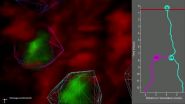Stroke researchers explore implications of ipsilateral spatial neglect after stroke
Further investigation needed to determine clinical implications of the differences between ipsilateral neglect and the more common contralateral neglect
2014-10-03
(Press-News.org) West Orange, NJ. October 3, 2014. Stroke researchers have confirmed that damage to the right frontal-subcortical network may cause ipsilateral spatial neglect. Among individuals with ipsilateral neglect, a much greater proportion had frontal subcortical damage than anticipated by the investigators – 83% vs the expected 27%. A difference was also seen in spatial bias, ie, the type of spatial errors among this group tended to be 'where' (perceptual-attentional) rather than 'aiming' (motor-intentional) errors. Ipsilesional Neglect: Behavioral and Anatomical Correlates (doi: 10.1037/neu0000122) was published online ahead of print on September 1 by Neuropsychology. The authors are Daniela L. Sacchetti and A.M. Barrett, MD, of Kessler Foundation, Kelly M. Goedert of Seton Hall University, and Anne L. Foundas of the University of Missouri.
The study was conducted in 12 patients with ipsilateral neglect. A computerized line-bisection task was used to evaluate spatial errors of 'where' and 'aiming' "Little is known about ipsilateral neglect, which is much less common than contralesional neglect," noted Dr. Barrett. "Our findings confirm that of prior studies showing that these patients tend to have lesions of the frontal-subcortical network. An unexpected finding was the spatial bias toward 'where' errors in this group. We need further investigation to determine the differences in functional deficits between ipsilateral and contralateral neglect, and the clinical implications of those differences for rehabilitation interventions."
The study was funded by National Institutes of Health (K02NS047099, K24HD062647, R01 NS055808, Barrett), National Institute on Disability and Rehabilitation Research (H133G120203, Barrett), Kessler Foundation.
INFORMATION:
About Stroke Rehabilitation Research at Kessler Foundation
Research studies span all domains of post-stroke cognitive dysfunction, but emphasize hidden disabilities after stroke, including hidden disabilities of functional vision (spatial bias and spatial neglect). Students, resident physicians, and post-doctoral trainees are mentored in translational neuroscience of rehabilitation. Dr. Barrett and her colleagues work closely with the clinical staff at Kessler Institute for Rehabilitation. Among their collaborative efforts are the founding of the Network for Spatial Neglect and development of the Kessler Foundation Neglect Assessment Process (KF-NAPTM). Stroke Research receives funding from the Department of Education/NIDRR; the National Institutes of Health/NICHD/NCMRR; Kessler Foundation; the Healthcare Foundation of New Jersey; and the Wallerstein Foundation for Geriatric Improvement. Scientists have faculty appointments at Rutgers New Jersey Medical School.
About A.M. Barrett, MD
A.M. Barrett, MD, a cognitive neurologist and clinical researcher, studies brain-behavior relationships from the perspectives of cognitive neurology, cognitive neuroscience, and cognitive neurorehabilitation. Dr. Barrett is an expert in hidden cognitive disabilities after stroke, which contributes to safety problems & rehospitalization, increased caregiver burden, & poor hospital-to-home transition. She is a founder of the Network for Spatial Neglect, which promotes multidisciplinary research for this underdiagnosed hidden disability. Dr. Barrett is also professor of physical medicine & rehabilitation at Rutgers New Jersey Medical School and adjunct professor of neurology at Columbia University School of Medicine. She is a former president of the American Society for Neurorehabilitation.
Dr. Barrett is author of the reference article Spatial Neglect on emedicine.com.
Relevant publications by Stroke Rehabilitation Research:
Barrett AM. Picturing the body in spatial neglect: descending a staircase. Neurology. 2013 Oct 8;81(15):1280-1.
Goedert KM, Chen P, Boston RC, Foundas AL, Barrett AM. Presence of motor-intentional aiming deficit predicts functional improvement of spatial neglect with prism adaptation. Neurorehabilitation and Neural Repair epub Dec 27 2013. DOI: 10.1177/1545968313516872
Barrett AM, Oh-Park M, Chen P, Ifejika NL. Five new things in neurorehabilitation. Neurology Clinical Practice. Epub Nov 13 2014. doi: 10.1212/01.CPJ.0000437088.98407.fa.
About Kessler Foundation
Kessler Foundation, a major nonprofit organization in the field of disability, is a global leader in rehabilitation research that seeks to improve cognition, mobility and long-term outcomes, including employment, for people with neurological disabilities caused by diseases and injuries of the brain and spinal cord. Kessler Foundation leads the nation in funding innovative programs that expand opportunities for employment for people with disabilities. For more information, visit KesslerFoundation.org; Facebook.com.KesslerFoundation; Tweet us @KesslerFdn
Contacts:
Carolann Murphy, 973.324.8382, CMurphy@KesslerFoundation.org
Lauren Scrivo, 973.324.8384, 973.768.6583 - c, LScrivo@KesslerFoundation.org
[Attachments] See images for this press release:

ELSE PRESS RELEASES FROM THIS DATE:
2014-10-03
A powerful scientific tool for editing the DNA instructions in a genome can now also be applied to RNA, the molecule that translates DNA's genetic instructions into the production of proteins. A team of researchers with Berkeley Lab and the University of California (UC) Berkeley has demonstrated a means by which the CRISPR/Cas9 protein complex can be programmed to recognize and cleave RNA at sequence-specific target sites. This finding has the potential to transform the study of RNA function by paving the way for direct RNA transcript detection, analysis and manipulation.
A ...
2014-10-03
VIDEO:
A software program developed by engineers at Drexel University, called Lineage Editing and Validation (LEVER), allows biologists to tag and track cell proliferation to validate lineage trees.
Click here for more information.
For hundreds of years biologists have studied cells through the lens of a microscope. With a little help from a team of engineers at Drexel University, these scientists could soon be donning 3-D glasses in a home-theater-like lab to take their own ...
2014-10-03
FALLS CHURCH, Va. (October 3, 2014) — A new National Institute for Occupational Safety and Health (NIOSH) study, published online in the Journal of Occupational and Environmental Hygiene, found that recommended safe handling practices for workers who administer antineoplastic drugs in healthcare settings are not always followed.
Results are derived from the 2011 Health and Safety Practices Survey of Healthcare Workers, the largest federally-sponsored survey of healthcare workers in the U.S., which addresses safety and health practices relative to use of hazardous chemicals. ...
2014-10-03
Washington, DC—The Endocrine Society today issued a Clinical Practice Guideline (CPG) advising against the use of testosterone therapy in healthy women.
The CPG, entitled "Androgen Therapy in Women: A Reappraisal: An Endocrine Society Clinical Practice Guideline," was published online in the Journal of Clinical Endocrinology and Metabolism (JCEM), a publication of the Endocrine Society. The Society updated its 2006 recommendations to address new research concerning testosterone and dehydroepiandrosterone (DHEA) therapy in women as well as advances in testosterone testing ...
2014-10-03
Luis Fernando Velásquez-García's group at MIT's Microsystems Technology Laboratories (MTL) develops dense arrays of microscopic cones that harness electrostatic forces to eject streams of ions.
The technology has a range of promising applications: depositing or etching features onto nanoscale mechanical devices; spinning out nanofibers for use in water filters, body armor, and "smart" textiles; or propulsion systems for fist-sized "nanosatellites."
In the latest issue of the IEEE Journal of Microelectromechanical Systems, Velásquez-García, his graduate students Eric ...
2014-10-03
Cincinnati, OH, October 3, 2014 -- Increasing rates of adolescent obesity and the likelihood that obesity will carry forward into adulthood, have led to various preventive initiatives. It has been suggested that family meals, which tend to include fruits, vegetables, calcium, and whole grains, could be protective against obesity. In a new study scheduled for publication in the Journal of Pediatrics, researchers studied whether frequent family meals during adolescence were protective for overweight and obesity in adulthood.
Jerica M. Berge, PhD, MPH, LMFT, CFLE, and ...
2014-10-03
In the field of medicine there has often been a divide between those who focus on modern medicine and those who prefer alternative practices. But pediatrician Sunita Vohra is a firm believer there should be room for both.
A new study from Vohra, a professor in the Faculty of Medicine & Dentistry's Department of Pediatrics at the University of Alberta, and a pediatric physician for Clinical Pharmacology with Alberta Health Services, is giving insight into the use of alternative medicines by pediatric cardiac patients and how effective they are seen to be. "We wanted to ...
2014-10-03
Tel Aviv — The incidence of type 1 childhood diabetes has been increasing rapidly worldwide. If blood sugar levels aren't well-controlled, juvenile diabetes can affect nearly every organ of a child's body. And while long-term complications of the disease develop gradually, they may become disabling and even life-threatening. The exact cause of juvenile diabetes has eluded scientists, but a new study from Tel Aviv University suggests a likely trigger before birth.
In a recent paper published in Diabetic Medicine, Prof. Zvi Laron, Professor Emeritus of Pediatric Endocrinology ...
2014-10-03
A team of researchers, led by the Optoelectronics Research Centre (ORC) at the University of Southampton, has demonstrated a breakthrough technique that offers the first possibility of silicon detectors for telecommunications.
For decades, silicon has been the foundation of the microelectronics revolution and, owing to its excellent optical properties in the near- and mid-infrared range, is now promising to have a similar impact on photonics.
The team's research, reported in the journal Nature Materials, describes engineering the electronic band structure of laser-crystallised ...
2014-10-03
A study conducted in more than 100 Mongolian schoolchildren found that daily treatment with a vitamin D supplement significantly reduced the symptoms of winter-related atopic dermatitis, a type of eczema. Led by a Massachusetts General Hospital (MGH) physician, the report in the October issue of the Journal of Allergy and Clinical Immunology supports the results of a preliminary study that showed similar results in a small group of children in Boston.
"While we don't know the exact proportion of patients with atopic dermatitis whose symptoms worsen in the winter, the ...
LAST 30 PRESS RELEASES:
[Press-News.org] Stroke researchers explore implications of ipsilateral spatial neglect after stroke
Further investigation needed to determine clinical implications of the differences between ipsilateral neglect and the more common contralateral neglect


